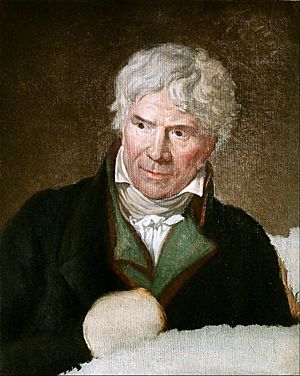Jean-Michel Moreau facts for kids
Jean-Michel Moreau (born March 26, 1741 – died November 30, 1814) was a famous French artist. He was known as a draughtsman (someone who draws), an illustrator (someone who creates pictures for books), and an engraver (someone who carves designs onto metal plates to print images). People often called him Moreau le Jeune, which means "Moreau the Younger."
Contents
A Talented Artist's Life
Moreau le Jeune was born in Paris, France. He learned his skills from the painter Louis-Joseph Le Lorrain. In 1758, Moreau went with his teacher to St Petersburg in Russia. Le Lorrain was starting the Saint Petersburg Academy of Fine Arts there. Moreau taught drawing for a short time before returning to Paris in 1759. This was after his teacher, Le Lorrain, sadly passed away.
Early Work and Collaborations
Back in Paris, Moreau worked for an engraver named Jacques-Philippe Lebas. He made drawings of paintings by other artists, both old and new. These drawings were then used by engravers to create prints. This is how Moreau learned the art of etching (a way of making prints).
In the 1760s, he also created drawings for the Recueil d’antiquités (a collection of old things) for the comte de Caylus. This count was a kind supporter of Moreau. Moreau also made drawings for the famous Encyclopédie by Diderot and Alembert. These drawings showed how different crafts and jobs were done. As an engraver, he worked with artists like François Boucher and Hubert Gravelot. They created pictures for a special edition of Ovid's Metamorphoses (a collection of ancient stories).
In 1765, Moreau married Françoise-Nicole Pineau. Her family was involved in sculpting and publishing.
Working for the King
In 1770, Moreau became the chief Dessinateur des Menus Plaisirs du Roi. This means he was the main designer for the King's special events and entertainment. He took over this important job from Charles-Nicolas Cochin. Because of this role, he created prints celebrating the marriage of the Dauphin (the king's son) and his crowning as Louis XVI.
In 1781, he was given another important title: Dessinateur et Graveur du Cabinet du Roi. This meant he was the King's official designer and engraver. This job came with a yearly payment and a place to live in the Palais du Louvre. Now, Moreau needed other engravers to help him print his many designs.
He created illustrations for the Chansons (songs) of Jean-Benjamin de La Borde (1773). He also illustrated the collected works of famous writers like Rousseau (1773–82) and Voltaire (1782–9). For the King's events, he drew many important occasions. One famous drawing shows the opening of Mme du Barry's beautiful Pavillon de Louveciennes in September 1771. He also found time to draw personal portraits using charcoal and chalk.
Later Life and Famous Works
Moreau was part of a group called Les Neuf Soeurs in 1778. This was a special club named after the Muses (goddesses of art and science). It was a place where people could share new and progressive ideas.
In 1785, he traveled to Italy for six months. He became a member of the important Académie Royale de Peinture et de Sculpture in 1789. The French Revolution began around this time, and Moreau supported it. The revolution did not stop his success as an illustrator. He continued to make drawings for engravers, like for a French translation of the Aeneid (an ancient Roman poem) published in 1804.
In 1793, Moreau was appointed to a temporary arts committee. In 1797, he became a professor at the newly reformed écoles centrales (central schools). When the Bourbon royal family returned to power in 1814, Louis XVIII gave him a royal job again. Moreau died in Paris.
Moreau had a very busy career. His most famous works are 24 illustrations that show the fashionable clothes and homes of the last years of the Ancien Régime (the old French government). These were part of his Monument du costume physique et morale (Monument of Physical and Moral Costume). These drawings showed an "idealized vision of an aristocratic family's approach to childbearing and motherhood." Later drawings in this series also hinted at some problems in aristocratic life and showed simpler, virtuous scenes from the countryside.
Moreau le Jeune's work became famous again in the late 1800s. This was thanks to art lovers like Edmond and Jules de Goncourt.
See also
 In Spanish: Jean-Michel Moreau para niños
In Spanish: Jean-Michel Moreau para niños


